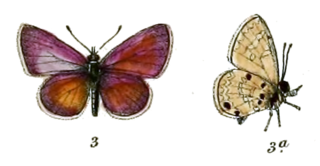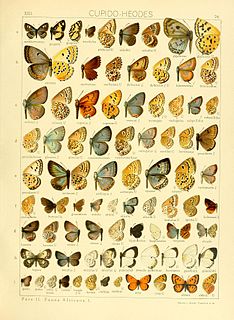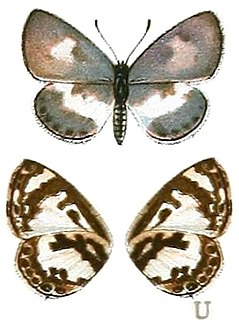
Azanus ubaldus, the bright babul blue, desert babul blue, or velvet-spotted blue, is a small butterfly found in India, the Middle East and Africa that belongs to the lycaenids or blues family.

Azanus uranus, the dull babul blue or Indian babul blue, is a small butterfly found in India that belongs to the lycaenids or blues family. It was first described by Arthur Gardiner Butler in 1886.
Azanus urios, the Siam babul blue, is a small butterfly found in India and Thailand that belongs to the lycaenids or blues family.

Azanus jesous, the African babul blue or topaz-spotted blue, is a small butterfly found in Africa, Egypt, Syria, India, Sri Lanka and Myanmar that belongs to the lycaenids or blues family.

Lampides boeticus, the pea blue, or long-tailed blue, is a small butterfly that belongs to the lycaenids or gossamer-winged family.

Azanus, commonly called babul blues, is a genus of butterflies found in Africa and southwestern Asia.

Vachellia xanthophloea is a tree in the family Fabaceae, commonly known in English as the fever tree. This species of Vachellia is native to eastern and southern Africa. It has also become a landscape tree in other warm climates, outside of its natural range.

Azanus natalensis, the Natal babul blue or Natal spotted blue, is a butterfly of the family Lycaenidae. It is found in the Afrotropical realm.

Zizeeria knysna, the dark grass blue or African grass blue, is a species of blue butterfly (Lycaenidae) found in Africa, on Cyprus and the Iberian Peninsula.

Zintha is a butterfly genus in the family Lycaenidae. It is monotypic, with the only species being Zintha hintza, the blue-eyed Pierrot, blue pied Pierrot or Hintza blue. The pied Pierrots proper are the closely related genus Tuxentius, however, and like Zintha they were formerly included in Castalius.

Anthene amarah, the black-striped hairtail, leaden hairtail or leaden ciliate blue, is a butterfly of the family Lycaenidae. It is found in tropical Africa and Arabia. The habitat consists of savanna and occasionally open areas in the forest zone.

Pseudonacaduba sichela, the African line blue, dusky line blue or dusky blue, is a butterfly of the family Lycaenidae. It is found in Africa, south of the Sahara.

Azanus mirza, the pale babul blue or mirza blue, is a butterfly of the family Lycaenidae. It is found in the Afrotropical realm.

Actizera stellata, the red-clover blue, is a butterfly of the family Lycaenidae. It is found in South Africa, Ethiopia, southern Sudan, Kenya, Uganda, Zaire, Tanzania and northern Malawi. In South Africa it is found in the East Cape and the southern part of the Orange Free State.
Azanus sitalces, the large Madagascar babul blue, is a butterfly in the family Lycaenidae. It is found on Madagascar and the Comoros. The habitat consists of forests.

Azanus soalalicus, the small Madagascar babul blue, is a butterfly in the family Lycaenidae. It is found on Madagascar. The habitat consists of forests.

Azanus isis, the white-banded babul blue, is a butterfly in the family Lycaenidae which is native to the tropics and subtropics of sub-Saharan Africa.

Empisini Nature Reserve was established in 1973 and is situated in Umkomaas, KwaZulu-Natal, South Africa. The reserve is approximately 60 ha in extent and is owned by the borough of uMkhomanzi which has been incorporated into the eThekwini municipality. Empisini is managed jointly by eThekwini and the Umkomaas centre of the Wildlife and Environment Society of South Africa. Empisini takes its name from a perennial stream which flows through it, and means "Place of the Hyena" in isiZulu. The reserve consists of coastal forest, wetlands, grassy slopes and a dam. Infrastructure consists of hiking trails, demarcated picnic sites, overnight cabins, and a tree house.















